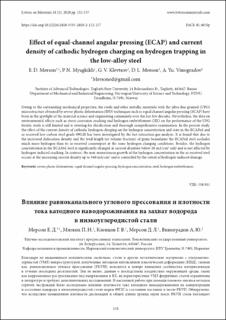| dc.contributor.author | Merson, Evgeni | |
| dc.contributor.author | Myagkikh, Pavel | |
| dc.contributor.author | Klevtsov, G.V. | |
| dc.contributor.author | Merson, Dmitry | |
| dc.contributor.author | Vinogradov, Alexey | |
| dc.date.accessioned | 2021-09-07T06:35:29Z | |
| dc.date.available | 2021-09-07T06:35:29Z | |
| dc.date.created | 2021-01-17T21:12:23Z | |
| dc.date.issued | 2020 | |
| dc.identifier.citation | Letters on Materials. 2020, 10 (2), 152-157. | en_US |
| dc.identifier.issn | 2218-5046 | |
| dc.identifier.uri | https://hdl.handle.net/11250/2773877 | |
| dc.description.abstract | Owing to the outstanding mechanical properties, the steels and other metallic materials with the ultra-fine grained (UFG) microstructure obtained by severe plastic deformation (SPD) techniques such as equal channel angular pressing (ECAP) have been in the spotlight of the material science and engineering community over the last few decades. Nevertheless, the data on environmental effects such as stress-corrosion cracking and hydrogen embrittlement (HE) on the performance of the UFG ferritic steels is still limited and is awaiting for clarification and thorough comprehensive examination. In the present study, the effect of the current density of cathodic hydrogen charging on the hydrogen concentration and state in the ECAPed and as-received low-carbon steel grade 09G2S has been investigated by the hot-extraction gas-analysis. It is found that due to the increased dislocation density and the total length (or volume fraction) of grain boundaries the ECAPed steel occludes much more hydrogen than its as-received counterpart at the same hydrogen charging conditions. Besides, the hydrogen concentration in the ECAPed steel is significantly changed at current densities below 20 mA / cm2 only and is not affected by hydrogen-induced cracking. In contrast, the non-monotonous growth of the hydrogen concentration in the as-received steel occurs at the increasing current density up to 340 mA / cm2 and is controlled by the extent of hydrogen-induced damage. | en_US |
| dc.language.iso | eng | en_US |
| dc.publisher | Institute for Metals Superplasticity Problems of Russian Academy of Sciences | en_US |
| dc.rights | Navngivelse 4.0 Internasjonal | * |
| dc.rights.uri | http://creativecommons.org/licenses/by/4.0/deed.no | * |
| dc.title | Effect of equal-channel angular pressing (ECAP) and current density of cathodic hydrogen charging on hydrogen trapping in the low-alloy steel | en_US |
| dc.type | Peer reviewed | en_US |
| dc.type | Journal article | en_US |
| dc.description.version | publishedVersion | en_US |
| dc.source.pagenumber | 152-157 | en_US |
| dc.source.volume | 10 | en_US |
| dc.source.journal | Letters on Materials | en_US |
| dc.source.issue | 2 | en_US |
| dc.identifier.doi | 10.22226/2410-3535-2020-2-152-157 | |
| dc.identifier.cristin | 1872728 | |
| cristin.ispublished | true | |
| cristin.fulltext | original | |
| cristin.qualitycode | 1 | |

